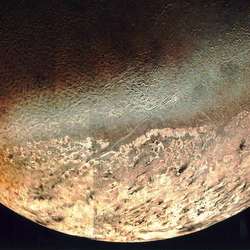
Neptune’s largest moon, Triton. Image credit: NASA. Click to enlarge
Neptune’s moon Triton is unique in the Solar System because it’s the only large moon that orbits in the opposite direction to its planet’s rotation. Researchers have developed a computer model that explains how Neptune could have captured Triton from another planet during a close approach. Under this scenario, Triton was originally part of a binary system with another planet. They got too close to Neptune and Triton was torn away.
Neptune’s large moon Triton may have abandoned an earlier partner to arrive in its unusual orbit around Neptune. Triton is unique among all the large moons in the solar system because it orbits Neptune in a direction opposite to the planet’s rotation (a “retrograde” orbit). It is unlikely to have formed in this configuration and was probably captured from elsewhere.
In the May 11 issue of the journal Nature, planetary scientists Craig Agnor of the University of California, Santa Cruz, and Douglas Hamilton of the University of Maryland describe a new model for the capture of planetary satellites involving a three-body gravitational encounter between a binary and a planet. According to this scenario, Triton was originally a member of a binary pair of objects orbiting the Sun. Gravitational interactions during a close approach to Neptune then pulled Triton away from its binary companion to become a satellite of Neptune.
“We’ve found a likely solution to the long-standing problem of how Triton arrived in its peculiar orbit. In addition, this mechanism introduces a new pathway for the capture of satellites by planets that may be relevant to other objects in the solar system,” said Agnor, a researcher in UCSC’s Center for the Origin, Dynamics, and Evolution of Planets.
With properties similar to the planet Pluto and about 40 percent more massive, Triton has an inclined, circular orbit that lies between a group of small inner moons with prograde orbits and an outer group of small satellites with both prograde and retrograde orbits. There are other retrograde moons in the solar system, including the small outer moons of Jupiter and Saturn, but all are tiny compared to Triton (less than a few thousandths of its mass) and have much larger and more eccentric orbits about their parent planets.
Triton may have come from a binary very similar to Pluto and its moon Charon, Agnor said. Charon is relatively massive, about one-eighth the mass of Pluto, he explained.
“It’s not so much that Charon orbits Pluto, but rather both move around their mutual center of mass, which lies between the two objects,” Agnor said.
In a close encounter with a giant planet like Neptune, such a system can be pulled apart by the planet’s gravitational forces. The orbital motion of the binary usually causes one member to move more slowly than the other. Disruption of the binary leaves each object with residual motions that can result in a permanent change of orbital companions. This mechanism, known as an exchange reaction, could have delivered Triton to any of a variety of different orbits around Neptune, Agnor said.
An earlier scenario proposed for Triton is that it may have collided with another satellite near Neptune. But this mechanism requires the object involved in the collision to be large enough to slow Triton down, but small enough not to destroy it. The probability of such a collision is extremely small, Agnor said.
Another suggestion was that aerodynamic drag from a disk of gas around Neptune slowed Triton down enough for it to be captured. But this scenario puts constraints on the timing of the capture event, which would have to occur early in Neptune’s history when the planet was surrounded by a gas disk, but late enough that the gas would disperse before it slowed Triton’s orbit enough to send the moon crashing into the planet.
In the past decade, many binaries have been discovered in the Kuiper belt and elsewhere in the solar system. Recent surveys indicate that about 11 percent of Kuiper belt objects are binaries, as are about 16 percent of near-Earth asteroids.
“These discoveries pointed the way to our new explanation of Triton’s capture,” Hamilton said. “Binaries appear to be a ubiquitous feature of small-body populations.”
The binary Pluto and its moon Charon and the other binaries in the Kuiper belt are especially relevant for Triton, as their orbits abut Neptune’s, he said.
“Similar objects have probably been around for billions of years, and their prevalence indicates that the binary-planet encounter that we propose for Triton’s capture is not particularly restrictive,” Hamilton said.
The exchange reaction described by Agnor and Hamilton may have broad applications in understanding the evolution of the solar system, which contains many irregular satellites. The researchers plan to explore the implications of their findings for other satellite systems.
This research was supported by grants from NASA’s Planetary Geology and Geophysics, Outer Planet Research, and Origins of Solar Systems programs.
Original Source: UC Santa Cruz
